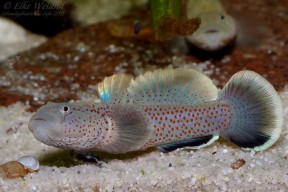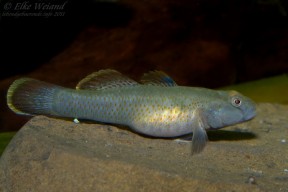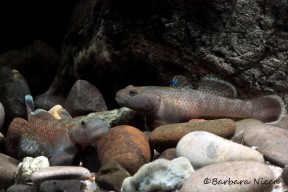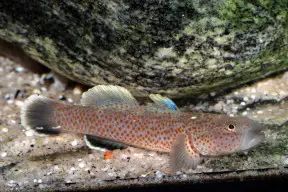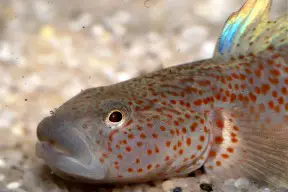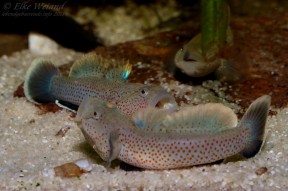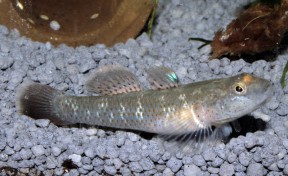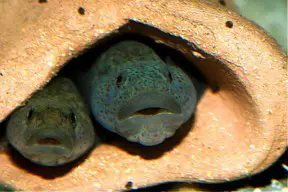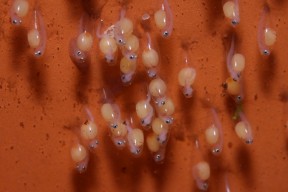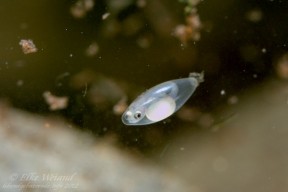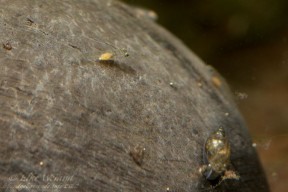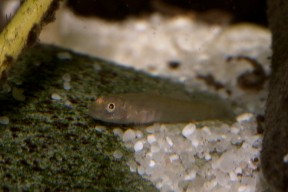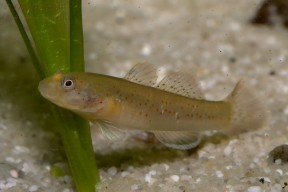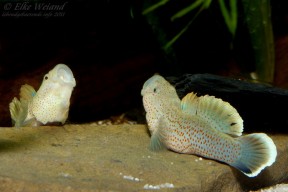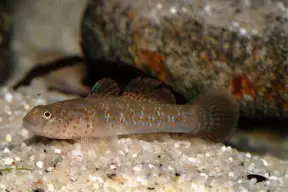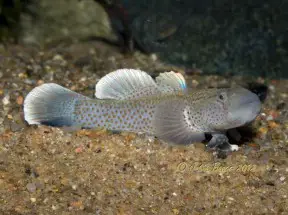Rhinogobius rubromaculatus
Red-spotted Goby
Etymology
Rhinogobius: from the Greek rhinos, meaning ‘nose’, and the generic name Gobius.
rubromaculatus: from the Latin ruber, meaning red, and maculosus, meaning spotted, in allusion to the colour pattern of red spots on the body.
Classification
Order: Perciformes Family: Gobiidae
Distribution
Endemic to Taiwan with type locality the Tadu river in Taichung County, and apparently quite common in central and western parts of the island, with the Tamshuei and Kaoping river basins representing the northern and southern limits of its range, respectively.
An additional population inhabiting the Linbian river in southern Taiwan is currently considered conspecific but exhibits several notable differences (see ‘Notes’).
Most of the systems in which it’s found drain into the Taiwan Strait,with a handful emptying into the East and South China Seas, and it’s absent entirely from eastward-flowing drainages.
Colour pattern and certain aspects of morphology can vary considerably between populations (see ‘Notes’).
Habitat
Inhabits both low and mid-elevation tributary and headwater streams from sea level to 1200 m AMSL, the majority of which are land-locked and lie in a humid, subtropical region where air temperatures rarely drop below 15.5°C/60°F, and can be much higher in summer.
The most typical habitats comprise small brooks, tributaries and pools with relatively slow water flow and substrates of rocks and pebbles.
During periods of high rainfall some streams may be temporarily turbid due to suspended material dislodged by increased, sometimes torrential, flow rate and water depth.
Maximum Standard Length
50 – 55 mm.
Aquarium SizeTop ↑
An aquarium with base dimensions of 60 ∗ 30 cm is large enough to house a small group.
Maintenance
Not difficult to maintain under the correct conditions; we strongly recommend keeping it in a tank designed to simulate a flowing stream with a substrate of variably-sized rocks, sand, fine gravel, and some water-worn boulders.
This can be further furnished with driftwood branches, terracotta pipes, plant pots, etc., arranged to form a network of nooks, crannies, and shaded spots, thus providing broken lines of sight.
While the majority of aquatic plants will fail to thrive in such surroundings hardy types such as Microsorum, Bolbitis, or Anubias spp. can be grown attached to the décor.
Like many fishes that naturally inhabit running water it’s intolerant to accumulation of organic pollutants and requires spotless water in order to thrive. Weekly water changes of 30-50% tank volume should also be considered routine.
Though torrent-like conditions are unnecessary it does best if there is a high proportion of dissolved oxygen and some water movement in the tank meaning power filter(s), additional powerhead(s), or airstone(s) should be employed as necessary.
Water Conditions
Temperature: 18 – 24 °C. It can temporarily withstand warmer conditions provided dissolved oxygen levels are maintained.
pH: 6.0 – 8.0
Hardness: 90 – 215 ppm
Diet
Rhinogobius spp. tend to be opportunistic carnivores feeding on a range of small invertebrates, crustaceans and similar in nature.
In the aquarium they should be offered small live or frozen foods such as chironomid larvae (bloodworm), mosquito larvae, Artemia, Daphnia, Mysis, etc.
Dried foods may be accepted following a period of acclimatisation but should not be used regularly.
Behaviour and CompatibilityTop ↑
Can be kept in a community provided tankmates are chosen with care.
Peaceful, pelagic species which inhabit similar environments in nature such as Tanichthys or Danio species are perhaps the best choices for the upper levels, but we’ve also seen Rhinogobius spp. being maintained alongside barbs, small characins, poeciliid livebearers, etc.
It should not mixed with other Rhinogobius spp. since it’s not yet clear if they’re capable of hybridisation, but other stream-dwelling gobies from genera such as Stiphodon, Sicyopterus, Sicyopus or Schismatogobius spp. generally make good companions.
Less suitable are freshwater shrimp from genera such as Caridina and Neocaridina as these are likely to be predated upon.
Other bottom-dwellers can include diminutive loaches from genera such as Gastromyzon, Pseudogastromyzon, or Acanthopsoides, and in high-turnover set-ups obligate torrent-dwellers like Annamia, Homaloptera, etc. Avoid those that feed aggressively or are excessively territorial, e.g., many Schistura spp.
Larger fishes are best omitted although in very large set-ups it may be possible to add a few non-predatory, surface-dwelling ones.
The majority of cichlids and other territorial fishes inhabiting the lower reaches should be avoided entirely.
While males are territorial with one another to an extent serious damage is unlikely provided the tank contains sufficient cover, and in fact they appear to actively require the presence of conspecifics.
Aim to purchase at least two males and as many or more females or the fish may become listless and inactive.
Sexual Dimorphism
Males tend to be a little larger, more colourful, develop more-extended dorsal and anal fins, and a broader head shape than females.
When females are gravid the eggs are visible as a bluish mass inside the body.
Reproduction
In nature reproduction occurs from May to August in summer and December to March in winter, though in aquaria it can be bred year-round and is among the less-problematic members of the genus to breed.
As is typical for the genus eggs are deposited on the ceiling of a cave or crevice and guarded by the male until hatching.
Several potential sites should be offered in the form of rocks (flat slate tends to be easiest to handle, see below), terracotta pipes, plant pots, etc.
A nuptial male will select a site and defend it against other males, but if one is not available may excavate a cave beneath a rock or other piece of décor.
Spawning occurs secretively within the cave, and is usually signified by the pair disappearing from sight for an extended period of time.
They may remain inside for 2-3 days with the female ejected once spawning is complete, and should not be disturbed during this period.
Once the female is seen outside the cave, you can check for eggs by carefully lifting and tilting it without removing from the water.
Inexperienced pairs or males may eat the eggs, attach them poorly, or only partially fertilise them, but after a few attempts normally get things right.
At this point it’s advisable to remove all other fish except the male, or remove male and eggs elsewhere ( a small plastic container can be used to do so without harming either).
Brood size is normally between 20-100 depending on the age and experience of the fish and the eggs are relatively large as with other fluvial members of the genus.
Incubation is normally 9-11 days and there is no pelagic stage, the fry hatching with only a small yolk sac attached and dropping to the substrate to forage straight away.
They can be offered Artemia nauplii, microworm, and suchlike immediately.
NotesTop ↑
This species occurs in a couple of colour forms with fish from northern and central Taiwan possessing a greyish base body colour and those from the Linbian river, southern Taiwan having a dark marking in the anterior portion of the first dorsal fin and larger, more intense red spots on the body.
The latter form is also smaller in size, lays smaller eggs, does not exhibit extreme sexual dimorphism and has been referred to as R. rubromaculatus ‘rot’ or ‘red’ in the hobby.
Despite these anomalies the populations were found to exhibit only minor genetic variance and thus are retained as a single species with the differences attributed to phenotypic plasticity (Cheng et al., 2005).
A third fish which has been traded as R. sp. ‘chrysanthemum’ and initially identified as a form of R. rubromaculatus appears to represent a different species.
There also exist two species of questionable identity from the Ryukyu Islands of Japan which have been referred to as R. sp. ‘yellow belly’ and R. sp. ‘blue belly’.
The latter in particular appears to be closely-related to the north and central Taiwanese form of R. rubromaculatus.
Like the mainland Chinese species R. davidi, R. lentiginis, R. multimaculatus and R. szechuanensis it possesses a reduced number of cephalic sensory pores on the head, specifically lacking a preopercular canal, and this single character is sufficient to distinguish it from all other Taiwanese Rhinogobius species as well as all those known from Japan.
It can be further distinguished from congeners by a combination of characters including: 15-17 (16) pectoral-fin rays; snout length usually less than 29 % of head length; postorbital around 52 % of head length; 27-28 vertebrae; body and fins, except anal-fin, with scattered red spots which on the pectoral-fin base are almost always arranged in two transverse series.
It’s included in the R. brunneus group of closely-related species within the genus of which members share the following combination of characters: predorsal naked, or with small cycloid scales, the scaled area never extending beyond the vertical of the posterior margin of the preoperculum; cheek with 2 mainly horizontal rows of sensory papillae.
In addition it belongs to an assemblage of fluvial, land-locked, non-diadromous Rhinogobious spp. which have relatively large eggs and 27-29 vertebrae.
The Gobiidae is the most speciose vertebrate family and notoriously problematic in terms of identifying fishes down to species level.
Within this sizeable assemblage Rhinogobius is often included in the subfamily Gobionellinae alongside genera such as Brachygobius, Chlamydogobius, Mugilogobius, Pseudogobiopsis, Schismatogobius, and Stigmatogobius.
Members can be told apart from these and all other gobiid genera by the following combination of characters: head with four simple, longitudinal infraorbital sensory papilla rows a, b, c, and d, single cp papilla, and paired papillae in mental row f; head canal variable from complete loss to normal development of anterior and posterior oculoscapular canals, and preopercular canals, and always with double interorbital pores λ if the pore is present; body mostly covered with ctenoid scales; longitudinal scale series 25–42; head including cheek, snout, opercle, anterior part of nape as well as pre-pectoral region all naked; D1 usually VI; D2 I, 6–11; A I, 5–11; P 14–23; and V I, 5 + I, 5, forming a rounded disc with frenum present, performing two pointed spinous lobes, the spinous ray usually longer than the first branched ray; dorsal pterygiophore formulae modally 3–22 1 101; vertebrae 25–29, usually 26 for most landlocked species.
The genus is widely-distributed throughout much of continental Asia in Russia, Korea, China, Vietnam, Laos, Cambodia, and Thailand, plus numerous islands of the Western Pacific including Japan, Taiwan, Hainan, and the Philippines.
There currently exist over 60 recognised species with many more awaiting formal description, and a number of the described ones are only considered nominal taxa pending additional study.
Those exhibiting similarities in appearance, morphology and behaviour are therefore often aggregated in nominal species groups, e.g., the R. brunneus group, R. duospilus group, etc., for ease of reference.
The fused pelvic fins form a structure normally referred to as the ‘pelvic disc’, a common feature among gobiids which is used to adhere to rocks and other submerged surfaces.
Rhinogobius spp. also exhibit different reproductive strategies depending on environment, with those inhabiting rivers connected directly to the sea typically amphidromous, and those landlocked in upper reaches of rivers or lakes non-diadromous.
Many of those appearing in the aquarium trade have proven difficult to identify for a number of reasons including:
– taxonomic confusion.
– lack of aquarium literature.
– incorrect labelling by exporters and subsequently shops.
– historical over-use of some names, e.g., ‘Rhinogobius wui‘ which is itself an invalid synonym of R. duospilus.
– likely trade of undescribed species without locality data.
– mixing of species at export facilities.
Thanks to Jutta Bauer.
References
- Lee, S.-C. and J.-T. Chang , 1996 - Zoological Studies 35(1): 30-35
A new goby, Rhinogobius rubromaculatus (Teleostei: Gobiidae), from Taiwan. - Chen, I-S. , H.-L. Wu, and K.-T. Shao, 1999 - Ichthyological Research 46(2): 171-178
A new species of Rhinogobius (Teleostei: Gobiidae) from Fujian Province, China. - Chen, I-S. and K.-T. Shao, 1996 - Zoological Studies 35(3): 200-214
A taxonomic review of the gobiid fish genus Rhinogobius Gill, 1859, from Taiwan, with description of three new species. - Chen, I-S. and L.-S. Fang, 2006 - Ichthyological Research 53(3): 247-253
A new species of Rhinogobius (Teleostei: Gobiidae) from the Hanjiang Basin in Guangdong Province, China. - Chen, I-S., Y.-H. Cheng, and K.-T. Shao, 2008 - Ichthyological Research 55(4): 335-343
A new species of Rhinogobius (Teleostei: Gobiidae) from the Julongjiang basin in Fujian Province, China. - Cheng, H-L., S. Huang, and S-C. Lee , 2005 - Zoological Studies 44(1): 119-129
Morphological and Molecular Variation in Rhinogobius rubromaculatus (Pisces: Gobiidae) in Taiwan.
